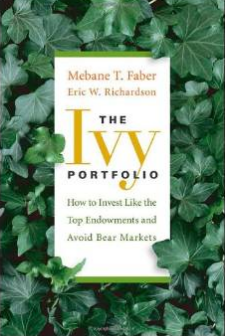Anyone reading this blog is probably familiar with Meb Faber. Before getting into a review of his newest project and ETF offering, I wanted to provide a little biographical background for anyone who may be unfamiliar with Meb. I first found out about Meb after reading The Ivy Portfolio:
The Ivy Portfolio details a simple, do-it-yourself strategy for investing like the big university endowments. You’ve heard of David Swensen and his success in managing the Yale endowment? Well, it turns out you don’t need to be David Swenson to realize portfolio results substantially similar to his. By applying some simple asset allocation concepts, and using low cost, tax-efficient ETFs to achieve target exposures, you can truly “do it yourself” and generate superior returns with less risk.
Meb also put active ETFs on the map with the launch of Cambria’s Shareholder Yield ETF (SYLD). This ETF’s strategy identifies companies with the highest shareholder yields, as measured by dividends, share repurchases, and debt repayment. It’s a sophisticated and sensible approach to investing that allows investors to take advantage of the combination of these three elements of shareholder yield in order to enhance risk-adjusted returns.
And Cambria is not only a unique provider of portfolio and investment advice, they are also just good guys who genuinely want to help people out: Meb and his teammate–Eric Richardson–have given us invaluable advice as we’ve entered the Active ETF space with our own active ETFs.
So having gotten to know Meb, Eric, and Cambria over the years, and being big believers in the momentum anomaly, we were especially intrigued to learn that Cambria is now launching a new active ETF, the Cambria Global Momentum ETF (ticker: GMOM). We sat down with Meb to try to learn a bit about this newest offering, and below we share some highlights from that recent discussion:
Tell us a little about your strategy? How many asset classes are included?
We include all of the main global asset classes – stocks, bonds, real estate, and commodities. We first sort approximately 50 ETFs by medium term momentum (roughly 1-14 months) to select the top 33% of the universe. Those funds are then only included in the portfolio if they are above their long term trend. Global Momentum is a long-term trend-following strategy with strict risk control methods that are completely systematic.
Do you have any research to demonstrates the broad fund strategies?
I published a white paper “A Quantitative Approach to Tactical Asset Allocation” way back in 2006 (and updated in 2013) that shows how historically sorting assets based on trailing measures of momentum and trend has led to outperformance. This fund will be aggressive as it is concentrated in only a third of the potential universe, but also risk aware as it has the ability to be up to 100% in cash and bonds depending on the trends in the markets.
Trend and momentum-based systems have had a tough time the past 5 years. What makes you think this time is different?
It depends on the markets you are focusing on. Trend-following has worked spectacularly well in various individual and commodity groups – silver, gold, and oil are all in bear markets currently with large drawdowns. US equities have had some nice trends to the upside which makes almost any comparison difficult. Typically trend-following can have the best relative returns when the main asset classes are going through long bear markets. That hasn’t happened since 2009, and I imagine will happen again one of these days. But any investment style has periods of over and underperformance. While we have looked at trend strategies for the last 115 years, a recent book came out with a 800 year backtest – that’s a long time!
Conclusion:
On the whole, we think this is another solid offering from Cambria, representing a thoughtful approach to momentum investing. There seems to be a distinct lack of products on the market that can provide low cost, tax-efficient exposure to the momentum anomaly, so diligent investors owe it to themselves to take a closer look.
About the Author: Wesley Gray, PhD
—
Important Disclosures
For informational and educational purposes only and should not be construed as specific investment, accounting, legal, or tax advice. Certain information is deemed to be reliable, but its accuracy and completeness cannot be guaranteed. Third party information may become outdated or otherwise superseded without notice. Neither the Securities and Exchange Commission (SEC) nor any other federal or state agency has approved, determined the accuracy, or confirmed the adequacy of this article.
The views and opinions expressed herein are those of the author and do not necessarily reflect the views of Alpha Architect, its affiliates or its employees. Our full disclosures are available here. Definitions of common statistics used in our analysis are available here (towards the bottom).
Join thousands of other readers and subscribe to our blog.


